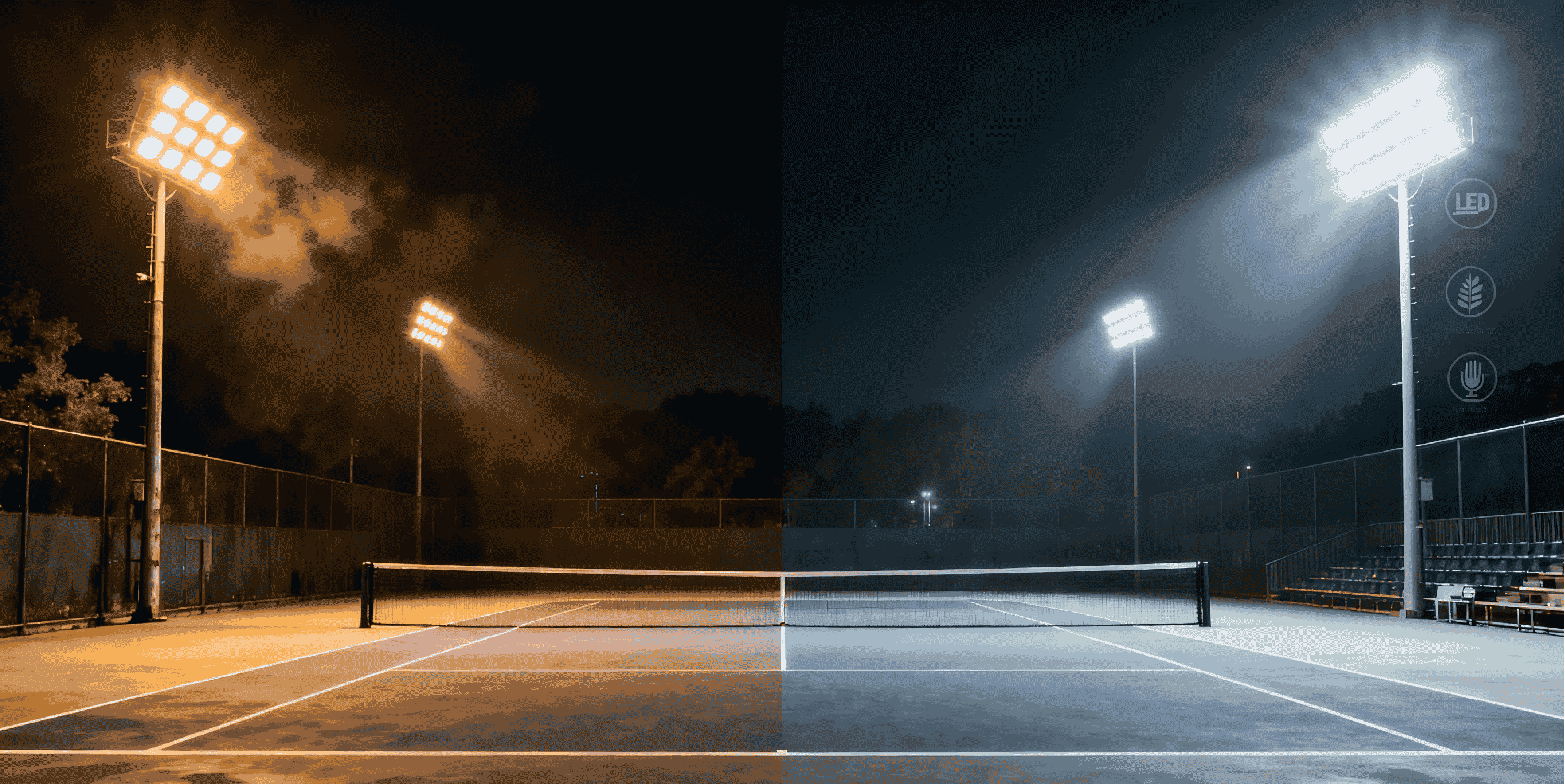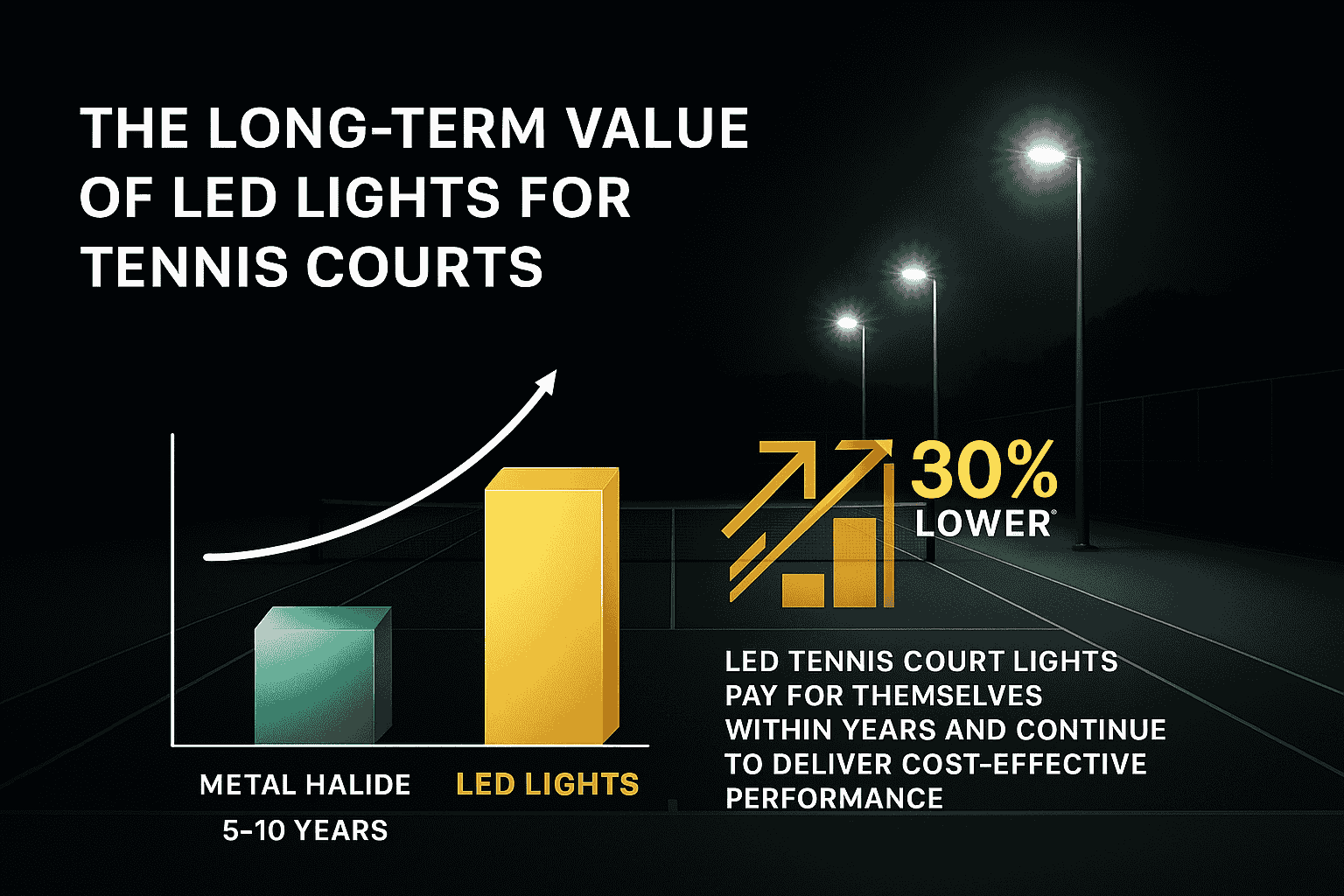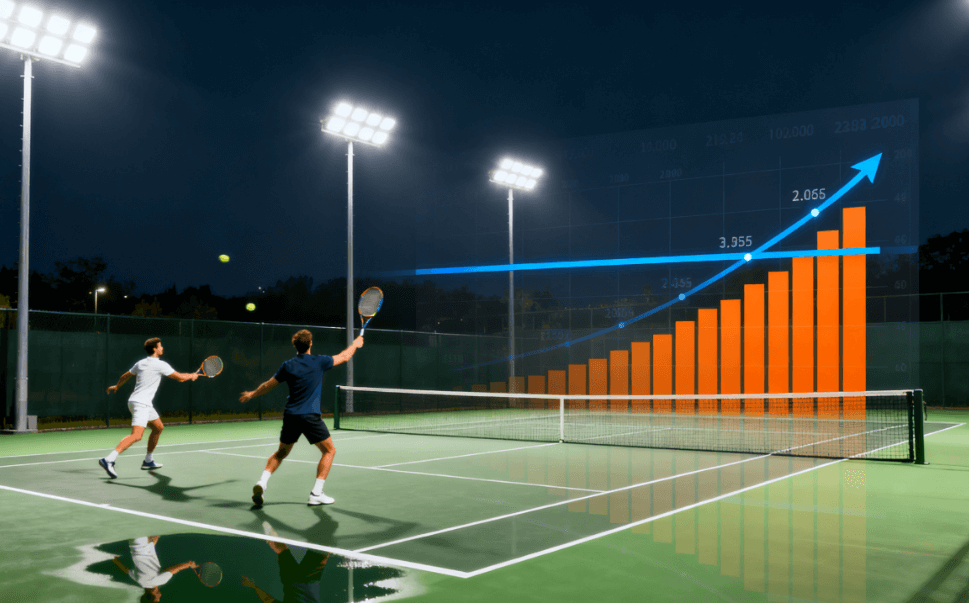Cost Analysis: Are LED Tennis Court Lights Worth the Investment in 2025?

In 2025, LED tennis court lights have reshaped how clubs, schools, universities, and municipalities approach illumination. That is because LED lighting in tennis facilities across the world defines player performance, safety, and the overall experience; it's not just about visibility. On the surface, conventional lighting systems like metal halide or high-pressure sodium lamps could appear more affordable, but the long-term financial picture is quite different.
For decades, traditional lighting systems such as metal halide or high-pressure sodium lamps were the default choice. They provided acceptable brightness at relatively low purchase costs. At first glance, these conventional light fixtures still appear less expensive than modern LED lighting solutions. However, the long-term financial picture tells a very different story once factors like energy consumption, maintenance, and lifespan are considered. Modern decision-makers need to move past sticker prices to grasp the genuine benefits of switching to LED lighting systems for tennis court illumination.
Upfront Costs vs. Long-Term Savings of LED Tennis Court Lights
When choosing LED tennis court lights, the key is balancing initial costs with long-term savings. While facility managers often prioritize upfront expenses, the broader perspective shows that selecting LED tennis court lights significantly impacts budgets over time due to their energy efficiency, low maintenance, and extended lifespan.
Upfront Investment in Tennis Court Lighting
High-quality LED tennis court lights typically cost about 20–30% more than conventional metal halide or high-pressure sodium systems at the time of purchase. For an outdoor tennis court, this translates into the need for 8–12 LED floodlights, depending on whether the court is designed for recreational use or competitive play that must meet strict standards. In actuality, a complete LED installation costs between $12,000 and $18,000, while a conventional metal halide system costs between $9,000 and $12,000. This gives the impression that LED lights are the more costly option at first glance.
However, focusing just on the purchase price misses the numerous hidden expenses of outdated lighting technologies, especially those related to electricity and continuing upkeep. When factors are taken into account, LED lights end up being the much more cost-effective choice.
Energy Efficiency and Operating Savings
The operational efficiency of LED tennis court lights is where they really shine. They provide brighter, more consistent illumination while using 40–60% less electricity than conventional bulbs. This results in yearly energy savings of $2,000 to $3,000 per court for a tennis club or sports complex that runs its lights five hours a night, twenty-five days a month. Over the course of the system, larger facilities with more courts or longer hours can save tens of thousands of dollars on power expenses. However, the savings can grow significantly.
In addition to significant cost savings, tennis court lighting offer substantial energy efficiency, aligning with sustainability goals. In 2025, as the focus on eco-friendly operations and minimizing carbon footprints intensifies, LED lights for tennis court not only reduce operational expenses but also establish facilities as environmentally conscious. This commitment to green technology resonates strongly with communities, educational institutions, and sports organizations, enhancing their reputation as responsible stewards of both resources and the environment.
The Long-Term Value of LED Lights for Tennis Courts
When evaluating costs over a 5–10 year timeframe, the economic benefits of LED tennis court lights are clear and compelling. Although the initial investment for tennis court lighting may be slightly higher than traditional metal halide systems, the long-term savings on electricity bills far outweigh this upfront cost. By the 10-year mark, the total cost of ownership for an LED system can be 30–50% lower than that of a comparable metal halide setup, driven by reduced energy consumption and lower maintenance expenses. These savings make LED tennis court lights a smart financial choice for facilities aiming for both performance and cost efficiency over the long term.

Stated differently, LED tennis court lights are an investment that pays for itself in a matter of years and continues to yield benefits for the duration of the system. When budget, performance, and sustainability are taken into consideration, LED lights for tennis court are unquestionably the better option in the long run.
Maintenance & Replacement: Cost Advantages of LED Tennis Court Lights
Beyond electricity bills, one of the most overlooked factors in evaluating tennis court lighting is the ongoing cost of maintenance. While it is easy to calculate energy savings, many facility managers underestimate the expense and inconvenience of keeping older lighting systems in working order. Over the life of a court, the difference between traditional fixtures and modern LED technology becomes striking.
The Expensive Upkeep of Conventional Lighting Systems
Once the standard for outdoor sporting venues, traditional metal halide and high-pressure sodium lighting need expensive and ongoing maintenance. These lightbulbs usually require replacement every two to three years, and their power-regulating ballasts frequently require maintenance or replacement at the same interval. In addition to the indirect cost of court outages that interfere with play and irritate users, each maintenance visit can cost $200 to $400 for personnel and parts.
Over a decade, these recurring costs can accumulate to thousands of dollars per court. For facilities managing multiple courts, the financial burden grows exponentially, straining budgets and diverting funds from other priorities. Additionally, metal halide lamps suffer from lumen depreciation, losing up to 30% of their brightness within the first year. This results in uneven lighting, increased glare, and diminished player experience well before bulbs are replaced, further compounding the drawbacks of traditional systems.
Tennis Court Lighting: Designed to Last
LED tennis court lights, on the other hand, are made to last and require little upkeep. High-quality LEDs can last 10 to 15 years without requiring bulb or ballast changes, with lifespans of 50,000 to 100,000 hours. This effectively eliminates maintenance costs for more than ten years. When compared to conventional systems, this durability results in significant labor, part, and operational interruption savings.
Additionally, unlike metal halide bulbs, which fade quickly, LED tennis court lights maintain a constant brightness and color quality over the course of their lifetime. LEDs provide consistent, excellent lighting that satisfies standards for both recreational and competitive use, giving players the best possible visibility and safety. LED tennis court lights are a popular option for contemporary facilities because of their dependability, which improves the playing experience.
The Hidden Advantage: Uninterrupted Operation
When it comes to both operational efficiency and financial performance, LED tennis court lights deliver unmatched benefits. For facilities such as clubs, schools, and municipalities, maintenance shutdowns can disrupt programming, frustrate players, and reduce revenue opportunities. Unlike traditional systems that require frequent bulb or ballast replacements, modern tennis court lighting with LED technology reduces servicing needs to almost zero. This ensures continuous facility availability—an essential advantage for venues that depend on steady usage and customer satisfaction.
Built with fluorescent transparent ceramic (FTC) LED materials, Ceramiclite LED sports lights deliver exceptional durability, antisulfuration and thermal stability. This advanced design reduces servicing requirements to almost zero, ensuring that courts remain consistently available for training, tournaments, and community programs.
From an operational perspective, uninterrupted tennis court lighting not only keeps players satisfied but also safeguards revenue by maximizing facility usage. Financially, the reduced maintenance and extended lifespan of Ceramiclite LEDs translate into substantial long-term savings.
Ceramiclite FTC LED vs. Traditional Metal Halide Tennis Court Lighting:
Feature | Ceramiclite FTC LED Tennis Court Lights | Traditional Metal Halide Lights |
Startup Time | Instant-on, full brightness immediately | 10–15 minutes warm-up required |
Energy Efficiency | 145–160 lm/W, up to 70% energy savings | 70–90 lm/W, high energy waste |
Lifespan | 50,000–100,000 hours (L80B10@102,000h) | 6,000–12,000 hours, frequent replacements |
Maintenance | Minimal, FTC materials resist heat, chemicals, and corrosion | Bulb and ballast replacement every 1–3 years |
Light Quality | Uniform illumination, CRI ≥ 80, glare control | Uneven lighting, fading output, higher glare |
Sustainability | Mercury-free, RoHS-compliant, eco-friendly | Contains hazardous materials like mercury |
Performance Stability | FTC core ensures long-term color stability and low decay | Significant lumen depreciation over time |
In essence, upgrading to Ceramiclite FTC LED lights for tennis courts more than a lighting enhancement—it is a strategic investment in cost-effectiveness, dependability, and superior user experience. Facilities that prioritize continuous operation and customer satisfaction gain a clear competitive edge with Ceramiclite's cutting-edge LED technology.
ROI of LED Tennis Court Lights: When Do They Pay Off?
The key question for decision-makers thinking about investing in LED tennis court lights is how quickly returns will be realized. Although the initial cost of LED tennis court lights may seem higher than that of traditional metal halide systems, they are a wise choice for long-term savings because of their quick and significant payback period.
Swift Payback: Unlocking Savings with LED Tennis Court Lights
For the majority of tennis facilities, whether they are clubs, universities, or municipal courts, the payback period for LED tennis court lights usually falls between two and three years. Two fundamental factors—significant energy savings and nearly zero maintenance costs—are responsible for this quick return on investment. Some facilities in high-electricity locations get a complete return on investment in as little as 18 to 24 months, turning LED tennis court lights from an initial investment into a potent cost-saving tool when contrasted with the recurring costs of conventional metal halide systems.
Payback Period: A Short Path to Savings
LED installations often pay for themselves in two to three years for the majority of towns, universities, and tennis clubs. The two main drivers of this comparatively short horizon are sharp drops in energy use and much decreased maintenance costs. Even faster returns may be seen by facilities situated in areas with higher electricity costs; some may even reach full ROI in as short as 18 to 24 months.
LED technology swiftly transforms from a capital expenditure to a revenue-saving asset when contrasted with conventional metal halide systems, which still have high electricity, light replacement, and maintenance expenses.
Case Studies: Proven Savings with LED Tennis Court Lights
1. Community Tennis Facility (USA)
A mid-sized community venue invested $15,000 in LED tennis court lights for its courts. With annual energy savings of $5,200 and maintenance cost reductions of approximately $1,000, the facility reached breakeven in just 2.4 years. After this point, the ongoing savings bolstered budgets for community programs, demonstrating the value of LED tennis court lights beyond mere cost recovery.
2. University Sports Complex
A larger project saw a university convert 12 competition-grade courts to LED tennis court lights for $180,000. With annual energy savings of $65,000 and minimal maintenance expenses, the payback period was just 2.7 years. Beyond financial returns, the upgrade enhanced lighting quality, improving visibility and performance for athletes during training and tournaments.
These case studies demonstrate a universal truth: LED tennis court lights provide a quick and reliable return on investment, making them perfect for facilities of all kinds, whether they are installed for a single leisure court or a multi-court complex.

In the long run, the payback advantage of LED sports lighting systems extends beyond cost alone. With better lighting quality, reduced downtime, and enhanced safety, facilities can attract more players, host more events, and create a superior experience—all of which contribute to stronger revenues and long-term sustainability.
Beyond Savings: How LED Tennis Court Lights Enhance Performance
While the cost-saving potential of LED tennis court lights often drives upgrades, their performance advantages are equally transformative, delivering superior playability, safety, and satisfaction for players and spectators alike.
Key Performance Benefits of Tennis Court Lighting
Instant-On Capability: One of the most practical advantages of LED tennis court lights is their ability to reach full brightness instantly. Unlike metal halide systems that need 10–15 minutes to warm up, Ceramiclite FTC LED lights for tennis courts provide immediate illumination, allowing facilities to start games, practices, or tournaments without delay.
Exceptional Light Uniformity: Consistency across the playing surface is essential for fair competition and enjoyable play. LED lights for tennis courts, particularly those built with Ceramiclite's fluorescent transparent ceramic (FTC) LED technology, eliminate shadows and dark spots while maintaining stable output over long hours of operation. This ensures optimal visibility from every angle of the court.
High Color Rendering Index (CRI): With a CRI rating of 80+ and color stability supported by FTC LED materials, tennis court lighting from Ceramiclite enhances contrast, making tennis balls and court lines stand out clearly under both recreational and professional conditions. This precision benefits athletes, referees, and spectators alike.
Reduced Glare: Discomfort and distractions caused by glare can affect performance and safety. Ceramiclite's advanced optical design minimizes glare while maintaining brightness, ensuring a comfortable experience for players on the court and fans in the stands.
By combining these performance advantages with the durability and efficiency of FTC materials, Ceramiclite SL03and SL04 LED tennis court lights set a new benchmark for reliability, safety, and professional-grade performance.
Conclusion: Why LEDs Are the Smart Investment
LED tennis court lights are not an expense but a long-term investment in both performance and sustainability when evaluating all factors—purchase price, energy efficiency, maintenance savings, lifespan, and player experience.
For clubs, schools, universities, and municipalities looking to balance cost control with enhanced performance, LED lights for tennis courts deliver unmatched value. While the upfront investment is slightly higher compared to traditional systems, the rapid payback period, significant reductions in energy bills, and minimal maintenance requirements make LEDs the clear choice for facilities that prioritize both financial efficiency and professional-quality illumination.
Beyond cost savings, LED technology also creates a better playing environment—offering uniform brightness, reduced glare, and instant-on functionality. These benefits translate into safer courts, improved visibility, and a more enjoyable experience for players and spectators alike.
For organizations seeking a reliable solution, Ceramiclite LED sports lighting systems, such as theSL03 model, provide the perfect balance of innovation, durability, and performance. Designed specifically for demanding sports environments, they ensure consistent lighting quality, long service life, and outstanding energy efficiency—helping facilities achieve their goals today and remain future-ready.
In short, upgrading to LED lighting—especially with trusted solutions like Ceramiclite—represents a smart, forward-thinking investment that pays dividends in cost savings, performance, and long-term sustainability.
_thumb.jpg)